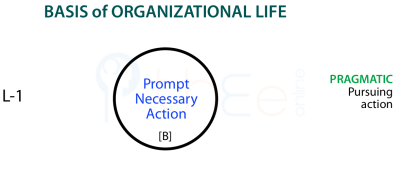Necessary Action: CL1
Pragmatism is about Action
is the final common pathway for organizations to survive and develop. So, irrespective of other matters, organizations absolutely require people to do things that are needed, often without too much delay.
Any choice that stays only as words—good intentions or fat documentation—is irrelevant. Decisions must be translated into action—or in what sense are they decisions?
Without confidence that necessary action can be taken immediately, whatever the situation, the organization is in crisis. The capacity to do something is therefore the final common pathway and foundation of organizational life—and its origin lies in the (CL1).
«Individual v Organization» Tension
Can an organization take action independently of at least one of its employees taking action? Obviously not.

Can an employee take actions at work that are not simultaneously regarded as actions of the organization? Obviously not.
So at this level the «individual v organization» duality is balanced i.e. fused or synthesized and there is just one centre, as represented here:
Action, however, must not be wild—it must have some justification; it must be checked and, if things go wrong, someone must explain what happened. Of course, in some cases, the absence of action requires explanation.
- This fact of organizational life takes us to the next level: the responsible control of work activities.
Originally posted: 17-Sep-2011